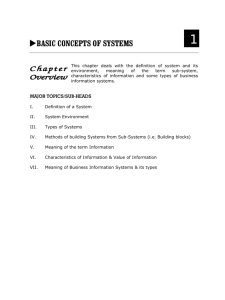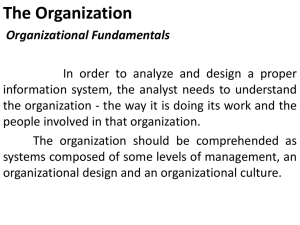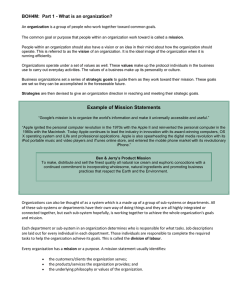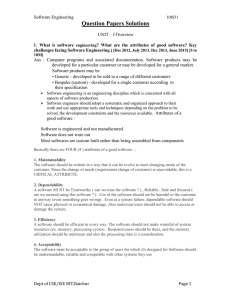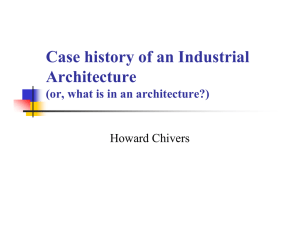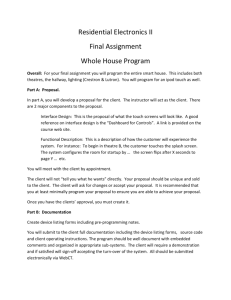Concurrent Engineering and Robot Prototyping
advertisement
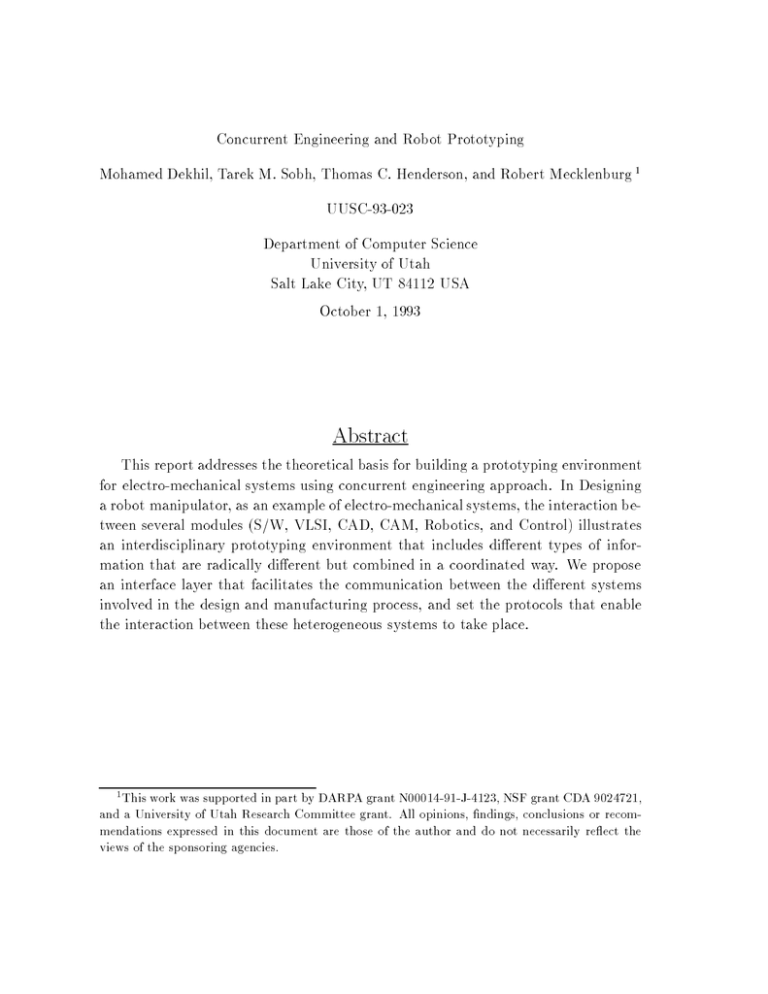
Concurrent Engineering and Robot Prototyping
Mohamed Dekhil, Tarek M. Sobh, Thomas C. Henderson, and Robert Mecklenburg 1
UUSC-93-023
Department of Computer Science
University of Utah
Salt Lake City, UT 84112 USA
October 1, 1993
Abstract
This report addresses the theoretical basis for building a prototyping environment
for electro-mechanical systems using concurrent engineering approach. In Designing
a robot manipulator, as an example of electro-mechanical systems, the interaction between several modules (S/W, VLSI, CAD, CAM, Robotics, and Control) illustrates
an interdisciplinary prototyping environment that includes dierent types of information that are radically dierent but combined in a coordinated way. We propose
an interface layer that facilitates the communication between the dierent systems
involved in the design and manufacturing process, and set the protocols that enable
the interaction between these heterogeneous systems to take place.
This work was supported in part by DARPA grant N00014-91-J-4123, NSF grant CDA 9024721,
and a University of Utah Research Committee grant. All opinions, ndings, conclusions or recommendations expressed in this document are those of the author and do not necessarily reect the
views of the sponsoring agencies.
1
Contents
1
2
3
4
Introduction
Objectives
Background and Review
The Interface Layer
4.1 Interaction Between Sub-systems
4.2 The Interface Scheme
3
4
5
7
: : : : : : : : : : : : : : : : : : : :
: : : : : : : : : : : : : : : : : : : : : : : : : : :
5 Object Analysis
6 Conclusion
13
19
20
25
List of Figures
1
2
3
4
5
Interaction Between Sub-systems in the Prototyping Environment.
Schematic View for the Robot Prototyping Environment.
The Interface Between the Subsystem and the Prototype Robot.
Examples of Some Interaction Cycles.
Three Dierent Ways for sub-system interfaces communication.
:
: : : : : :
: :
: : : : : : : : : : : : : : : : :
: : :
4
9
11
19
21
List of Tables
1
2
3
4
The interaction between the user and the sub-systems.
The interaction between the optimal design and the other sub-systems.
The interaction between CAD/CAM and the other sub-systems.
The interaction between hardware and other sub-systems.
: : : : : : : :
: :
: : : : : :
2
15
16
17
18
1 Introduction
In designing and building an electro-mechanical system, such as robot manipulators, a
lot of tasks are required, starting with specifying the tasks and performance requirements, determining the robot conguration and parameters that are most suitable
for the required tasks, ordering the parts and assembling the robot, developing the
necessary software and hardware components (controller, simulator, monitor), and
nally, testing the robot and measuring its performance.
Our goal is to build a framework for optimal and exible design of robot manipulators with the required software and hardware systems and modules which are independent of the design parameters, so that it can be used for dierent congurations
and varying parameters. This environment will be composed of several sub-systems.
Some of these sub-systems are:
Design.
Simulation.
Control.
Monitoring.
Hardware selection.
CAD/CAM modeling.
Part Ordering.
Physical assembly and testing.
Each sub-system has its own structure, data representation, and reasoning methodology. On the other hand, there is a lot of shared information among these subsystems. To maintain the consistency of the whole system, an interface layer is
proposed to facilitate the communication between these sub-systems, and set the
protocols that enable the interaction between these heterogeneous sub-systems to
take place.
Figure 1 shows the interaction between some of those sub-systems. The optimal
design system aects the control and the simulation systems. The monitor sub-system
3
Simulation
Monitoring
Design
Robot
Control
Figure 1: Interaction Between Sub-systems in the Prototyping Environment.
takes its data from the simulator and from the robot. There is also feedback information from the monitor to the optimal design system to rene the design according to
the performance measurements for each design. The robot is derived by the control
system, and feedback information goes from the robot sensors to the control system.
A prototype 3-link robot manipulator was built to help determine the required subsystems and interfaces to build the prototyping environment, and to provide hands-on
experience for the real problems and diculties that we would like to address and
solve using this environment. More details about this can be found in 10].
2 Objectives
The objective of this research project is to explore the basis for a consistent software
and hardware environment, and a exible framework that enables easy and fast modications, and optimal design of robot manipulator parameters, with online control,
monitoring, and simulation for the chosen manipulator parameters. This environment
should provide a mechanism to dene design objects which describe aspects of design,
and the relations between those objects. The importance of this project arises from
several points:
This framework will facilitate and speed the design process of robots.
4
This project will facilitate the cooperation of several groups in our Computer
Science department (VLSI group, Robotics group), and the cooperation of the
department with other departments (Mechanical and Electrical Engineering).
This project will establish a basis and framework for design automation of robot
manipulators.
The interdisciplinary nature of the proposed research will provide an exceptional
educational environment for those involved in the work.
This report is divided into three parts: rst, a brief background for concurrent
engineering and heterogeneous systems is presented with the related work in this area.
Second, the proposed interface layer between the systems is described. Finally, the required representations (knowledge base, object oriented scheme, rule-based reasoning,
etc.), are discussed.
3 Background and Review
There are several denition for the term Concurrent Engineering (CE). One denition proposed by Cleetus 2] is: \CE is a systematic approach to integrated product
development that emphasizes response to customer expectations and embodies team
values of cooperation, trust, and sharing in such a manner that decision making proceeds with large intervals of parallel working by all life-cycle perspectives early in the
process, synchronized by comparatively brief exchanges to produce consensus."
Dwivedi and Sobolewski 6] proposed an architecture of a concurent engineering
system composed of four levels as follows:
An object-oriented data base.
An intelligent data base engine.
A high-level interface.
A high-level tools.
In this architecture, several technologies are used to build the system such as:
object-oriented programming.
5
expert systems.
visual programming.
database and information retrieval.
To integrate the work among dierent teams and sites working in a big projects,
there must be some kind of synchronization to facilitate the communication and cooperations between them. A concurrent engineering infrastructure that encompasses
multiple sites and subsystems called Pallo Alto Collaborative Testbed (PACT), was
proposed in 3]. The issues discussed in this work were:
Cooperative development of interfaces, protocols, and architecture.
Sharing of knowledge among heterogeneous systems.
Computer-aided support for negotiation and decision-making.
An execution environment for heterogeneous systems called \InterBase" was proposed in 1]. It integrates preexisting systems over a distributed, autonomous, and
heterogeneous environment via a tool-based interface. In this environment each system is associated with a Remote System Interface (RSI) that enables the transition
from the local heterogeneity of each system to a uniform system-level interface.
Object orientation and its applications to integrate heterogeneous, autonomous,
and distributed systems is discussed in 9]. The argument in this work is that objectoriented distributed computing is a natural step forward from the client-server systems of today. A least-common-denominator approach to object orientation as a key
strategy for exibly coordinating and integrating networked information processing
resources is also discussed. An automated, exible and intelligent manufacturing
based on object-oriented design and analysis techniques is discussed in 8], and a
system for design, process planning and inspection is presented.
Several important themes in concurrent software engineering are examined in 4].
Some of these themes are:
Tools: Specic tool that support concurrent software engineering.
Concepts: Tool-independent concepts are required to support concurrent software
engineering.
6
Life cycle: Increase the concurrency of the various phases in the software life cycle.
Integration: Combining concepts and tools to form an integrated software engineering task.
Sharing: Dening multiple levels of sharing is necessary.
A management system for the generation and control of documentation ow
throughout a whole manufacturing process is presented in 5]. The method of quality assurance is used to develop this system which covers cooperative work between
dierent departments for documentation manipulation.
A computer-based architecture program called the Distributed and Integrated Environment for Computer-Aided Engineering (Dice) which address the coordination
and communication problems in engineering, was developed at the MIT Intelligent
Engineering Systems Laboratory 11]. In their project they address several research
issues such as, frameworks, representation, organization, design methods, visualization techniques, interfaces, and communication protocols.
Some important topics in software engineering can be found in 7], such as, the
lifetime of a software system, Analysis and design, module interfaces and implementation, and system testing and verication.
4 The Interface Layer
The prototyping environment for robot manipulators consists of several sub-systems
such as:
Design.
Simulation.
Control.
Monitoring.
Hardware selection.
CAD/CAM modeling.
7
Part Ordering.
Physical assembly and testing.
Figure 2 Shows a schematic view of the prototyping environment with its subsystems and the interface.
There is a lot of shared parameters and information among these sub-systems. To
maintain the integrity and consistency of the whole system, a multi-site interface is
proposed with the required rules and protocols for passing information through the
whole system. This interface will be the layer between the robot prototype and the
sub-systems, and also it will serve as a communication channel between the dierent
sub-systems.
The tasks of this interface will include:
Building relations between the parameters of the system, so that any change in
any of the parameters will automatically perform a set of modications to the
related parameters on the same system, and to the corresponding parameters
in the other sub-systems.
Maintaining a set of rules that governs the design and modeling of the robot.
Handling the communication between the sub-systems using a specied protocol
for each system.
Identifying the data format needed for each sub-system.
Maintaining comments elds associated with some of the sub-system to keep
track of the design reasoning and decisions.
The diculty of building such interface arises from the fact that it deals with
dierent systems, each has its own architecture, knowledge base, and reasoning mechanisms. In order to make these systems cooperate to maintain the consistency of the
whole system, we have to understand the nature of the reasoning strategy for each
sub-system, and the best way of transforming the information to and from each of
them.
There are several mechanisms used in these sub-systems which can be classied
as follows:
8
Optimal
Design
Hardware
Selection
Simulation
Interface
Robot
Prototype
Control
CAD/CAM
Modeling
Part
Ordering
Monitoring
Assembly
and
Testing
Figure 2: Schematic View for the Robot Prototyping Environment.
9
Constrained-based approach: this approach is used in the optimal design
sub-system.
Ruled-based approach: used in the the CAD/CAM and the hardware se-
lection sub-systems. These rules are used to assist decision making during the
design process.
Search-based approach: used in the part-ordering sub-system, which is basically, catalog search for the required parts (motors, sensors, ampliers, linkmaterials, etc). This system will be the front-end of an internet-based cataloging
system developed at the Mechanical Engineering Department.
Functional relations: used for building the relations between some of the
design parameters. For example, link lengths is one of the parameters that has
relations with other parameters such as masses and inertia tensors, and also it
takes place in the design, control, and simulation systems. If we change the
length of one of the links, we want the corresponding mass and inertia tensor
to change with a pre-specied functions that relates the length to each of them.
We also want the length in the other sub-systems to change as well according
to pre-specied mathematical relations.
Mathematical Formulation: used in the simulation, and control sub-systems
to dene the robot modules (kinematics, inverse kinematics, dynamics, etc).
Shared Database Manipulation: used in most of the sub-systems. For
example, the simulation and control are just retrieving data from the shared
database, while the monitor subsystem adds analysis information to the database
that will be used as a feedback to the design sub-system. The design subsystem updates the parameters of the system. The CAD/CAM system uses
this database to check the validity of the chosen parameters and adds to the
database some comments about the design and manufacturing problems that
might exist.
Since we are dealing with dierent architectures and approaches, we will use an
object-oriented scheme to design this interface. Each object deals with one of the
sub-systems in its own language. This will make it easier to change the approach or
the structure of any of the sub-system without aecting the other sub-systems, by
only changing the corresponding object in the interface. Figure 3 shows the proposed
interface layer.
10
Simulation
Control
Monitoring
Hardware
CAD/CAM
Selection
Modeling
Optimal Design
Part Ordering
Mathematical
Rule-based
Constrained
Search
Formulation
Programming
Programming
Algorithms
Knowledge Base
Robot prototype
Figure 3: The Interface Between the Subsystem and the Prototype Robot.
11
In this environment the human role should be specied and a decision should be
taken about which systems can be fully automated and which should be interactive
with the user. The following example will illustrate the mechanism of this interface
and the way these systems can communicate to maintain the system consistency.
Suppose that the designer wants to change the length of one of the links and he
wants to see what should be the motor parameters that give the same performance
requirements. First, this change will be recorded and the length eld will be updated
in the shared database for each sub-system. Then the optimal design will be used
to determine the new values for the motor parameters using the simulation program.
Then search techniques will be used to look up for the motor with the required
specications in the part-ordering system. Here we have two cases: a motor with the
required specications is found in the catalogs, or no motor is available with these
specication, in this case, this will be recorded in the comments eld and another
motor with closest specications will be selected. Next, The motor specications will
be updated in the database, then the CAD/CAM system will be used to generate
the new model and to check the feasibility of the new design. For example, the new
motor might have a very high rpm, which requires gears with high reduction ratio.
This might not be possible in some cases when the link width is relatively small and
a sprocket is hard to install. In this case, this will be recorded in the comments led
and the user will be notied with this problem and will be asked to either change the
some of the parameters or the performance requirements and the loop starts again.
Once the parameters is determined, the monitoring program will be used to give
some performance analysis and compare the results with the required performance,
and produces a report with the results.
As another example, suppose that we need to select link masses and motor parameters that give maximum speed and minimum position error. The design sub-system
will select density of the links material from the nite density set, and will use the
part-ordering system to select the motor and try to get the best combination of motor
parameters and link masses that give best value for the combined objective function
(speed and position error). The optimization problem here will be solved using the
simulation programs. After selecting the required parameters, the CAD/CAM system will be used to generate the model and again to see if this is a valid model to
be manufactured. In some cases the motor might be too heavy relative to the link
weights (usually when we have small links). In this case the simulation results will
show that and another motor should be selected, or another density should be chosen.
12
Finally the parts can be ordered and the assembly can take place.
4.1 Interaction Between Sub-systems
To be able to specify the protocols and data transformation between the sub-systems
in the environment, the types of actions and dependencies among these sub-systems
should be identied, also the knowledge representation used in each sub-system should
be determined.
The following are the dierent types of actions that can occurs in the environment:
Apply relations between parameters.
Satisfy rules.
Satisfy constraints.
Make decisions. (usually the user Makes the decisions).
Search in tables or catalogs.
Update data les.
Deliver reports (text, graphs, tables, etc.).
There are several data representations and sources such as:
Input from the user.
Data les.
Text les (documentation, reports, messages).
Geometric representations (Alpha-1).
Mathematical Formula.
Graphs.
Catalogs and tables.
Rules and constraints.
13
Programs written in dierent languages (C, C++, Lisp, Prolog, etc.).
Some of the sub-systems can change some of the parameters and the conguration of the prototype system. The Optimal design sub-system is the one that make
almost all the changes in the design parameters. The CAD/CAM sub-system can
also make some design changes according to some geometric and manufacturing rules
and constraints. The user can change any of the design parameters, make decisions,
and run any of the sub-systems.
Tables 1, 2, 3, and 4 describe the interaction between the sub-systems that
is, what each sub-system needs to know when if some of the design parameters are
changed by one of the sub-systems or by the user, and what actions it might take as
a consequence of this change.
The following is a description for the actions that may take place in the environment as a result of changing some of the design parameters.
Change constraints and optimize: When any change occurs to one of the design
parameters, that means changing in one of the constraints for the optimization
problem, then the user can decide whither to rerun the optimal design system
or not.
Update le: Updating the data les used by the simulation, control, and monitoring
sub-systems.
Apply relation: Some of the parameters are related to other parameters in the
same sub-system, and to corresponding parameters in other sub-systems. For
example, the relation between the link length in the design sub-system and the
corresponding drawing length in the monitoring sub-system can be something
like:
Design ,
Monitor =
where,
is the scaling factor to draw the link on the computer's screen.
Select D/A, D/A chips: When the motors and the sensors are selected, a chip that
contains the D/A and A/D converters and the micro-programs that control the
conversion should be selected by the hardware selection sub-system.
Select platform: According to the selected update frequency and the number of
computation in each sub-system, the hardware selection sub-system will select
the machines that can accommodate that frequency.
L
LinkS cale
linkS cale
14
L
System Lengths Masses Motors Frequency Sensors Feedback Friction
Table 1: The interaction between the user and the sub-systems.
15
System
Lengths
Masses
Motors
Frequency
Sensors
Simulation
Update le
Update le
Update le
Update le
Update le
Control
Update le
Update le
Update le
Update le
Update le
Apply relation
Max torque
Apply relation
Display rate
Apply relation
Max pos,vel
D/A chip
Select platform
A/D chip
Monitoring
Apply relation
Drawing length
HW Selection
CAD/CAM
Update model
Update model
Update model
Check for length Check for weight Check gear ratio
Part-ordering
Search and
give report
Assembly
Change link
Test, report
Search and
give report
Change link
Test, report
Change motor
Test, report
Change sensors
Test, report
Table 2: The interaction between the optimal design and the other sub-systems.
16
System
Lengths
Masses
Gear Ratio (Motor)
Simulation
Update le
Update le
Update le
Control
Update le
Update le
Update le
Apply relation
Drawing length
Update le
Apply relation
Max torque
Monitoring
HW Selection
Optimal Design
Select D/A chip
Optimize for
Optimize for
other parameters other parameters
Part-ordering
Assembly
Optimize for
other parameters
Search and
give report
Change link
Change link
Change motor
and gears
Table 3: The interaction between CAD/CAM and the other sub-systems.
17
System
Platform (Update rate) Communication (Feedback rate)
Simulation
Update le
Update le
Control
Update le
Update le
Apply relation
Display rate
Apply relation
Display rate
Optimize for
other parameters
Optimize for
other parameters
Monitoring
Optimal Design
Table 4: The interaction between hardware and other sub-systems.
Update model: The CAD/CAM sub-system will create a new model for the prototype robot according to the changes in the design parameters.
Check for length, mass, gear ratio and friction: Apply the rules and constraints
for each of these parameters that are imposed by geometric and manufacturing
limitations.
Search and give report: After the motor specication and the sensor ranges are
selected, the part-ordering sub-system will search in the parts catalogs to nd
the required motors and sensors. If no motors or sensors are found with the
required specications, this will be reported to the user, and the some other
motors or sensors with close specications will be recommended.
Change parts, test, and report: This is the nal step in the design. After all
parameters are selected and all parts are available, the assembly process can
take place, then the design can be physically tested, and the results are reported
to the user.
In some cases there might be interaction cycles. in such cases, the user has to
take decisions that resolve these cycles. For example, suppose that the link length was
determine by the design sub-system, but the CAD/CAM system has some rules that
18
Change
length
CAD/CAM
Change
length
Optimize
Optimal Design
The User
Report
Motor
Specs.
Other
motors
Part-ordering
Figure 4: Examples of Some Interaction Cycles.
requires the length to be changed. In this case the design sub-system needs to be run
again to accommodate this change. this might change the motor parameters or sensor
ranges, and again, this change may violate another rule in the CAD/CAM sub-system
which requires another change, and so on. To resolve this cycle the user can take some
design decisions that will satisfy the rules and constrains in the sub-systems.
The part-ordering sub-system can cause some indirect changes to the design parameters. For example if a motor with certain specications is not found, then this
sub-system will report that to the user and may recommend some other motors that
have close specications to the required. The user then can either choose one of
the recommended motors, or make some design changes and run the optimal design
sub-system to get new motor specications. Figure 4 shows some interaction cycles.
4.2 The Interface Scheme
There are several schemes that can be used for the interface layer. One possible
scheme is that: each sub-system will have a sub-system interface (SSI) which has the
following tasks:
Transfer data to and from the sub-system.
19
Send requests from the sub-system to the other interfaces.
Receive requests from other sub-system interfaces and translate it to the local
language.
5):
These sub-system interfaces can communicate in three dierent ways, (see Figure
Direct connection: which means that all interfaces can talk to each other. the
advantage of this method is that it has a high communication speed, but it
makes the design of such interfaces more dicult, and the addition of new
interface or changing one of the interfaces requires the modication of all other
interfaces.
Message routing: in this scheme, any request or change in the data will generate
a message on a common bus and each SSI is responsible to pick the relevant
messages and translate it to its sub-system. The problem with this scheme that
it makes the synchronization between the sub-systems very dicult, and the
design of the interface will be more complicated.
Centralized control: in which all interfaces will talk with one centralized interface
that controls the data and control ow in the environment. The advantages
of this scheme is that it makes it much easier to synchronize between the subsystems, and the addition or modication of any of the SSIs will not aect the
other SSIs. The disadvantage is that it has lower communication rates than the
other two methods.
5 Object Analysis
The interface layer contains several components that dene the objects in the environment, the relation between these objects, the rules and constraints in the system, the
representation of these objects in each sub-system, and the communication protocols
between the sub-systems.
Object analysis approach will be used to determine the system components and
functions, and the relation between them. The following is a description of the system
objects.
20
System 1
System 2
SSI 1
SSI 2
Knowledge Base
Common Bus
SSI 3
SSI 4
System 3
System 4
SSI 1
SSI 2
SSI 3
System 1
System 2
System 3
(2) Message Routing
(1) Direct Connection
Knowledge Base
Central Interface
SSI 1
SSI 2
SSI 3
System 1
System 2
System 3
(3) Centralized Control
Figure 5: Three Dierent Ways for sub-system interfaces communication.
21
Robot-prototyping
{
{
{
{
{
{
{
{
{
{
Robot
Rules
Constraints
Relations
communication
Sub-systems
Reports
Actions
Hardware-setup
Performance-measures
Robot
{
{
{
{
Robot-conguration
Control
Input
Results
Rules
{ Parameters
{ Sub-systems
{ Description
Constraints
{ Parameters
{ Sub-systems
{ Description
Relations
{ Object-elds
22
{ Sub-systems
{ Relation-type
{ Relation-formula
Communication
{ Protocols
{ Messages
{ Routing
Sub-systems
{
{
{
{
{
{
{
{
Optimal-design
Simulation
Control
Monitoring
CAD/CAM
Part-ordering
HW-selection
Assembly-and-testing
Reports
{
{
{
{
Report-type
Source
Destination
Report-contents
Actions
{
{
{
{
Action-type
Sub-system
Action-parameters
Report
23
Hardware-setup
{ Platform
{ Wiring
{ A/D-D/A-converters
Performance-measures
{
{
{
{
{
Position-error
Velocity
Power-consumption
Manipulability
Structured-length-index
Robot-conguration
{
{
{
{
{
{
Degrees-of-freedom
Links
Joints
Oset
Motors
Sensors
Control
{
{
{
{
{
Torque
Voltage
Update-rate
Sensor-rate
Feedback-gains
Input
{ Input-type
{ Time-period
24
{ Desired-Trajectory
Results
{
{
{
{
Actual-position
Simulated-position
Actual-velocity
Simulated-velocity
Links
{
{
{
{
Length
Density
Inertia-tensor
Cross-section
Joints
{ Type
{ Friction
6 Conclusion
A exible prototyping environment for electro-mechanical systems in general, and
for robot manipulators in particular is proposed. So far we have implemented some
of the sub-systems such as: controller, simulator, and monitor, We are now in the
stage of testing the three-link robot, implementing the optimal design sub-system,
and putting the basis for the shared knowledge base and the interface layer.
25
References
1] Bukhres, O. A., Chen, J., Du, W., and Elmagarmid, A. K. Interbase:
An execution environment for heterogeneous software systems. IEEE Computer
Magazine (Aug. 1993), 57{69.
2] Cleetus, K. J. Dinition of concurrent engineering. CERC Technical Report
Series (1992).
3] Cutkosky, M. R., Engelmore, R. S., Fikes, R. E., Genesereth, M. R.,
Gruber, T. R., Mark, W. S., Tenenbaum, J. M., and Weber, J. C.
PACT: An experiment in integrating concurrent engineering systems. IEEE
Computer Magazine (Jan. 1993), 28{37.
4] Dewan, P., and Riedl, J. Toward computer-supported concurrent software
engineering. IEEE Computer Magazine (Jan. 1993), 17{27.
5] Duhovnik, J., Tavcar, J., and Koporec, J. Project manager with quality
assurance. Computer-Aided Design 25, 5 (May 1993), 311{319.
6] Dwivedi, S. N., and Sobolewski, M. Concurrent engineering - an introduction. CERC Technical Report Series (1990).
7] Lamb, D. A. Software Engineering Planning for Change. Prentice Hall, 1988.
8] Marefat, M., Malhorta, S., and Kashyap, R. L. Object-oriented intelligent computer-integrated design, process planning, and inspection. IEEE
Computer Magazine (Mar. 1993), 54{65.
9] Nicol, J. R., Wilkes, C. T., and Manola, F. A. Object orientation in
heterogeneous distributed computing systems. IEEE Computer Magazine (June
1993), 57{67.
10] Sobh, T. M., Dekhil, M., and Henderson, T. C. Prototyping a robot
manipulator and controller. Tech. Rep. UUCS-93-013, Univ. of Utah, June 1993.
11] Sriram, D., and Logcher, R. The MIT dice project. IEEE Computer
Magazine (Jan. 1993), 64{71.
26
